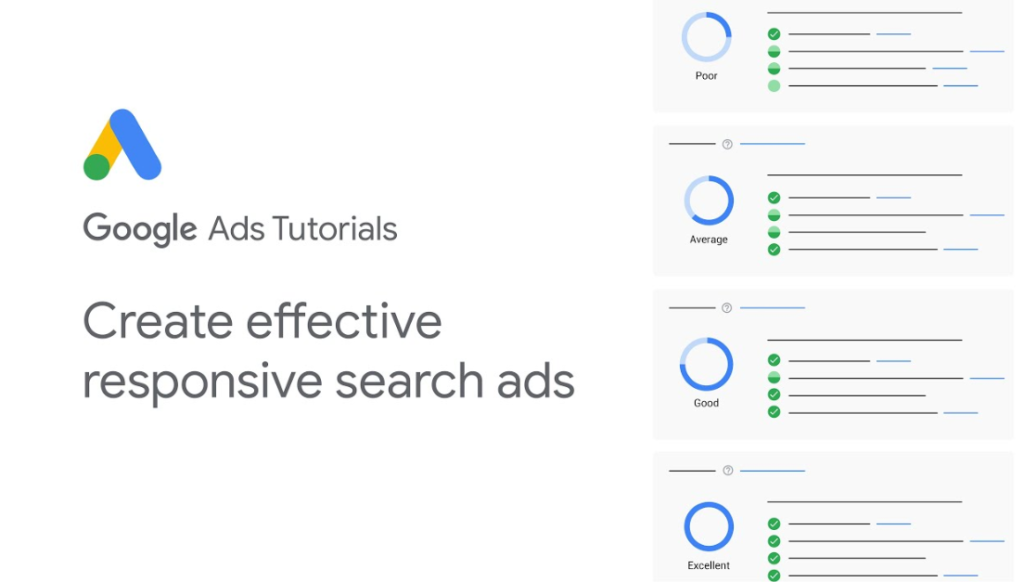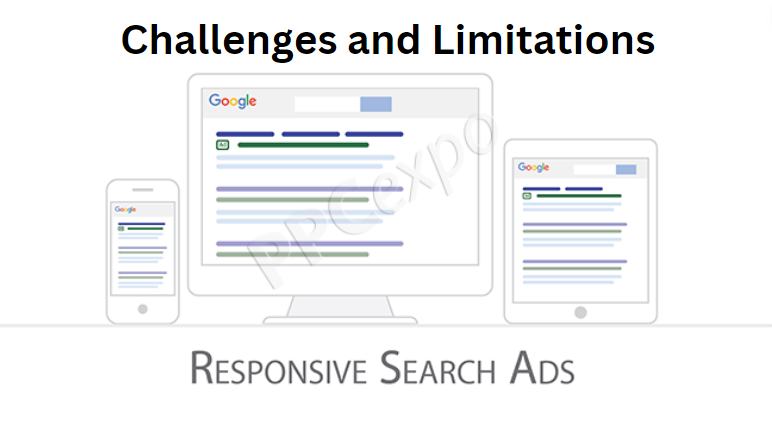Google Ads, is a powerful advertising platform that is very useful for businesses to create and manage online advertisements. It enables advertisers to reach their target audience through various ad formats across the Google network, including search, display, video, and app campaigns.
Responsive search ads play a crucial role in digital marketing campaigns by offering dynamic ad formats that adapt to different devices and formats. They provide advertisers the flexibility to input multiple headlines and descriptions, allowing for optimization based on user search queries and device types. This adaptability enhances the effectiveness of ad campaigns and improves the overall user experience.
This blog comprehensively explains the mechanics behind Google Ads‘ responsive search ads. By exploring the complexities of responsive search ads, we aim to equip readers with the knowledge and insights necessary to effectively control this powerful advertising tool in their digital marketing strategies.
How Google Ads Generate Responsive Search Ads
Understanding Responsive Search Ads (RSAs)
Responsive search ads (RSAs) are a dynamic ad format introduced by Google in 2018. They allow advertisers to create multiple headlines and descriptions, which are tested over time by Google’s machine learning.
This testing process enables the system to determine the most effective combinations of headlines and descriptions for displaying relevant ads customized to the end-user based on their search query. RSAs offer advertisers the flexibility to input up to 15 headlines and 4 descriptions, allowing for a wide range of ad variations to be tested and optimized.
Advantages of Using RSAs Over Traditional Search Ads
The advantages of using RSAs over traditional search ads are significant. RSAs adapt ad copy to display more relevant messages to potential customers, improving ad performance over time. They allow for more information about products and services to be included, as they can display up to three headlines and two descriptions.
Additionally, RSAs leverage machine learning to determine the best performing ad combinations, enhancing their effectiveness in reaching and engaging the target audience.
Components of Responsive Search Ads
The components of responsive search ads include headlines, descriptions, and paths. Advertisers can input up to 15 headlines and 4 descriptions, providing ample opportunity to test various combinations. Optional paths allow advertisers to specify the text in the ad’s display URL, providing additional customization and relevance to the ad’s destination.
How RSAs Adapt to Different Devices and Ad Formats
RSAs adapt to different devices and ad formats through Google’s machine learning and automation. The system varies combinations of the provided headlines and descriptions to determine which ads perform best over time, ultimately displaying the best performing ads. This adaptability ensures that the ads are tailored to the user’s search query and the device they are using, enhancing the overall relevance and effectiveness of the ad.
Mechanics Behind Google Ads’ Responsive Search Ads

Responsive search ads (RSAs) are a dynamic ad format that automatically adapts to fit various ad spaces across the Google Display Network (GDN) and Google Search. When creating an RSA, advertisers can input multiple headlines and descriptions, and over time, Google Ads tests different combinations to determine the most effective ones.
This allows for up to 32,760 different versions of the same ad to be shown in different instances, with the search engine learning and using the most effective title and description combination more frequently.
It’s important to note that RSAs have replaced expanded text ads (ETAs) as the only form for creating new ads inside a standard search campaign, with the transition taking place from June 30, 2022.
However, existing ETAs continue to run alongside RSAs, and advertisers can still pause, resume, or remove ETAs if needed. The ad format offers benefits such as personalized and optimized ad content, simple A/B testing, and the potential to compete in more auctions and reach a wider audience.
Advertisers are encouraged to transition to RSAs and leverage their capabilities to create more relevant and effective ad experiences for users.
Machine Learning and Automation in Ad Creation
Google’s responsive search ads leverage machine learning and automation to deliver more relevance and value to consumers. By combining creativity with the power of Google’s machine learning, advertisers can provide up to 15 headlines and 4 description lines, allowing Google to test different combinations and learn which ad creative performs best for any search query.
This process enables the delivery of relevant and personalized ads, meeting the expectations of today’s more curious and demanding consumers. On average, advertisers who use Google’s machine learning to test multiple creatives see up to 15 percent more clicks, highlighting the effectiveness of this approach.
Google’s Optimization Algorithms
Google’s optimization algorithms play a crucial role in determining the most effective combinations of headlines and descriptions for responsive search ads. These algorithms continuously test and optimize ad content to ensure that the most relevant and valuable ads are delivered to users. By leveraging generative AI in ads, Google aims to help advertisers manage complexity and improve performance, highlighting the integration of advanced technologies in ad optimization.
Dynamic Ad Generation Based on User Intent and Context
Responsive search ads dynamically adapt to user intent and context, ensuring that the displayed ads are tailored to the specific search query and the device being used. This dynamic ad generation is driven by Google’s AI, which sets the right bids, reaches the right searches, and creates the most relevant ad for consumers.
Advertisers who improve their responsive search ads’ Ad Strength can observe 12% more conversions on average, emphasizing the impact of dynamic ad generation based on user intent and context.
A/B Testing and Performance Monitoring for RSAs
A/B testing and performance monitoring are integral to optimizing responsive search ads. Google’s machine learning continuously tests different combinations of headlines and descriptions to determine the best-performing ad creative for any search query. This iterative testing process, combined with performance monitoring, ensures that the ads delivered are relevant, valuable, and effective in engaging the target audience.
Step-by-Step Process of Generating Responsive Search Ads
Creating a Responsive Search Ad Campaign
Creating a responsive search ad campaign involves entering a minimum of 2 descriptions, with the option to enter up to 4. It’s essential to focus on providing as many unique headlines as possible, as this gives Google Ads more options to assemble messages into relevant ads, potentially increasing performance. Additionally, creating variations of the entered headlines can provide even more options for ad assembly. Once the ad is created, it’s important to monitor and optimize its performance to ensure effectiveness.
Writing and Optimizing Headlines and Descriptions
When writing headlines and descriptions for responsive search ads, it’s important to include at least one of the targeted keywords in the headlines and create relevant content. Providing unique headlines and descriptions is key, and testing different combinations is encouraged to maximize the effectiveness of the ads. Avoiding repetitive and boring variants of the same headline is essential, as Google may not display the ad if the headlines or descriptions are too similar.
Utilizing Ad Strength Indicators and Best Practices
Ad Strength indicators provide feedback to help focus on providing the right messages to customers. The indicators range from Incomplete to Excellent, guiding advertisers in creating compelling ad content. It’s recommended to aim for at least 10 different headlines and 3 descriptions in responsive search ads to leverage their testing capabilities. Additionally, highlighting different value propositions, offers, and calls to action with each element of the ad is advised for optimal performance.
Setting Up Targeting Options for RSAs
Setting up targeting options for responsive search ads involves utilizing Google’s machine learning to test and optimize ad content. Advertisers can add up to 15 headlines and 4 descriptions, allowing for a wide range of ad variations to be tested and optimized. It’s crucial to consider testing multiple RSAs per ad group to leverage continuous testing and refinement for improved performance.
Monitoring and Adjusting RSAs for Performance Optimization
After creating responsive search ads, it’s essential to monitor their performance and make adjustments as needed. This includes analyzing the success of the ads based on incremental impressions, clicks, and conversions, and optimizing the campaign as it is created. Advertisers should also consider testing multiple RSAs within one ad group to perform A/B tests separate from Google’s testing, allowing for further refinement and optimization.
Best Practices and Tips for Maximizing the Effectiveness of Responsive Search Ads
Responsive search ads (RSAs) offer a dynamic way to reach potential customers with tailored ad content. To maximize their effectiveness, consider the following best practices and tips:
- Implement at least one responsive search ad with ‘Good’ or ‘Excellent’ Ad Strength per ad group. Advertisers who improve Ad Strength for their RSAs from ‘Poor’ to ‘Excellent’ see 9% more clicks and conversions on average.
- Incorporate assets such as sitelinks and images to make ads more engaging and provide helpful information about your business. More eligible assets give ads more opportunity to meet users’ specific needs.
- Write compelling, genuine ad copy that focuses on user benefits and entices users with different offers in the descriptions.
- Create variation by writing unique titles and descriptions to experiment with different header lengths and types of descriptions.
- Utilize ad extensions like site links, call-outs, and snippets for maximum exposure.
- Experiment with different offers in your descriptions to entice users and include keywords, product features, and benefits where possible.
- Regularly review ad performance and make adjustments based on insights gained from the testing process.
Conducting Keyword Research and Using Relevant Keywords in RSAs
Conducting thorough keyword research and incorporating relevant keywords into responsive search ads is crucial for maximizing their effectiveness. By aligning the ad content with the targeted keywords, advertisers can enhance the ad’s relevance and visibility, ultimately improving its performance and impact on the target audience.
Testing Different Combinations of Headlines and Descriptions
Testing various combinations of headlines and descriptions is essential for optimizing the performance of responsive search ads. By experimenting with different ad variations, advertisers can identify the most effective combinations that resonate with their audience and drive better results. This iterative testing process allows for continuous refinement and improvement of ad content.
Utilizing Ad Extensions with RSAs
Utilizing ad extensions alongside responsive search ads can enhance the ad’s visibility and provide additional information to potential customers. Ad extensions offer opportunities to include extra details, such as links to specific pages, contact information, or additional text, thereby enriching the ad’s content and increasing its relevance to users.
Implementing Ad Scheduling and Bid Adjustments for RSAs
Implementing ad scheduling and bid adjustments for responsive search ads enables advertisers to optimize the ad delivery based on specific time frames and adjust bids to maximize the ad’s performance during peak periods. This strategic approach allows for efficient budget allocation and improved targeting, ultimately enhancing the effectiveness of the ads.
Analyzing Performance Metrics and Making Data-Driven Decisions
Analyzing performance metrics, such as click-through rates, conversion rates, and other relevant KPIs, is essential for evaluating the effectiveness of responsive search ads. By leveraging data-driven insights, advertisers can make informed decisions to refine and optimize their ad campaigns, ensuring that the ads deliver the desired results and meet the campaign objectives.
Challenges and Limitations of Responsive Search Ads

- The challenges and limitations of responsive search ads (RSAs) include limited control over the combinations of headlines and descriptions displayed, as this is determined by Google’s machine learning.
- Additionally, creating and optimizing RSAs may require more time and effort due to the need to provide multiple variations for testing.
- Another challenge arises from the transition from expanded text ads to RSAs, as advertisers need to adapt to the new ad format and optimize their campaigns accordingly.
Despite these challenges, RSAs offer benefits such as personalized and optimized ad content, simple A/B testing, and the potential to compete in more auctions and reach a wider audience.
Advertisers can address these challenges by creating diverse sets of headlines and descriptions, regularly reviewing ad performance, and leveraging ad extensions to enrich the ad content and address some of the limitations of RSAs.
Potential Drawbacks of Using RSAs
While responsive search ads (RSAs) offer numerous benefits, they also come with potential drawbacks. One limitation is the limited control over which combinations of headlines and descriptions are displayed, as this is determined by Google’s machine learning.
Additionally, the ad format may require more time and effort to create and optimize due to the need to provide multiple variations of headlines and descriptions for testing.
Addressing Common Issues and Troubleshooting Tips
To address common issues and optimize the use of RSAs, advertisers can focus on creating a diverse set of headlines and descriptions to provide Google Ads with ample options for testing and optimization. It’s important to regularly review ad performance and make adjustments based on the insights gained from the testing process.
Additionally, leveraging ad extensions alongside RSAs can enhance the ad’s visibility and provide additional information to potential customers, addressing some of the limitations of RSAs and enriching the ad’s content.
Conclusion:
In conclusion, the future of responsive search ads (RSAs) and Google Ads automation is poised for significant advancements driven by AI, machine learning, and automation. The evolution of RSAs and ad creation technologies is expected to usher in a new era of personalized and effective ad experiences, leveraging data-driven insights and AI-driven optimization.
As digital advertising continues to evolve, staying ahead of the curve in Google Ads optimization will require embracing AI-driven ad creation, leveraging data analytics for insights, and maintaining a proactive approach to testing and refining ad content.
With these trends and best practices, advertisers can maximize the potential of RSAs and drive compelling and relevant ad experiences across various platforms and devices.
FAQs:
What are responsive search ads (RSAs), and how do they differ from traditional ad formats?
Responsive search ads (RSAs) are a dynamic ad format that adapts to fit various ad spaces across the Google Display Network and Google Search. They differ from traditional ad formats by allowing advertisers to input multiple headlines and descriptions, which are then tested and optimized by Google Ads using machine learning.
How can advertisers stay ahead of the curve in Google Ads optimization in the face of evolving ad formats and technologies?
Advertisers can stay ahead by embracing AI-driven ad creation and testing, leveraging data analytics for insights, and staying informed about industry best practices. Proactive testing and refining of ad content, along with staying abreast of industry updates and innovations, are crucial for staying competitive in the dynamic landscape of digital advertising.
What are the challenges and limitations of responsive search ads (RSAs), and how can advertisers address them?
Challenges and limitations of RSAs include limited control over the combinations of headlines and descriptions displayed and the effort required to create and optimize multiple variations. Advertisers can address these challenges by creating diverse sets of headlines and descriptions, regularly reviewing ad performance, and leveraging ad extensions to enrich the ad content.
What are the emerging trends in digital advertising and their impact on responsive search ads (RSAs)?
Emerging trends in digital advertising, such as personalization, AI-driven optimization, and cross-channel integration, are expected to influence the effectiveness and adoption of RSAs. The integration of advanced technologies and data-driven strategies will shape the future landscape of digital advertising, impacting the way RSAs are created, tested, and optimized.
How can advertisers maximize the effectiveness of responsive search ads (RSAs) in their campaigns?
Advertisers can maximize the effectiveness of RSAs by implementing at least one RSA with ‘Good’ or ‘Excellent’ Ad Strength per ad group, incorporating assets such as sitelinks and images, writing compelling ad copy, and experimenting with different offers in the descriptions. Regularly reviewing ad performance and making adjustments based on insights gained from the testing process are also crucial for maximizing the potential of RSAs.

